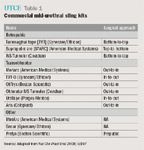Article
Mid-urethral slings: Techniques and outcomes
Mid-urethral slings represent a significant advance in the treatment of stress urinary incontinence, which levies a severe toll on the quality of life of millions of American women. This article examines the expanding family of mid-urethral slings and techniques that have defined the modern approach to anti-incontinence surgery.

Key Points


Historical background
The most significant recent advance in sling surgery originated in the development of separate and novel theories to detail the etiology of SUI, forwarded by DeLancey (ie, the hammock theory) and Petros/Ulmsten (the integral theory).4 While a complete description of these respective theories is beyond the scope of this review, they describe a complex interaction between vaginal wall and periurethral ligamentous structures that act to prevent SUI. Indeed, these theories are varied and broad in their scope. Nonetheless, the clinical application of such concepts was seen in the subsequent repositioning of the sling to a more distal location beneath the urethra, and was appropriately described as the mid-urethral sling.






